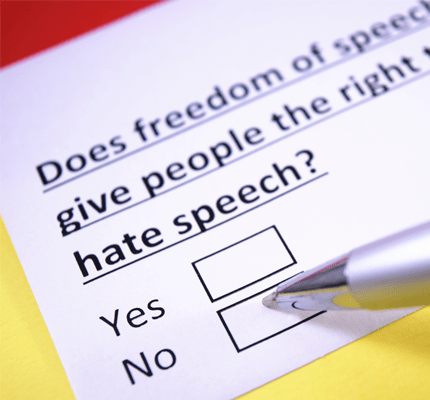
Regulating Hate Speech on College Campuses
Free speech standards on campuses usually protect hate speech because such speech is not considered a “true threat,” meaning that it does not endanger a specific individual. In addition, hate speech has also been protected because of limits against “viewpoint” discrimination. However, interpreting hate speech as workplace harassment against women and minorities on campus may provide a legal basis for limiting such speech. In a new article in First Amendment Studies, Craig R. Smith tackles the question of when hate speech becomes harassment.
Smith offers several cases in which the Supreme Court found that hate speech on campus did not rise to the level of a “true threat.” For example, in 1989, a student at the University of Connecticut placed a poster on their door that suggested that “bimbos,” “preppies,” “racists,” “homos,” and others should be shot on sight. The university expelled the student; however, the court overruled the university because there was no specific threat against a group or person. Other court cases involved a student invoking another student’s name in a violent story, a fraternity staging a performance in black face, and the distribution of racist t-shirts on campus. In all of these cases, the highest courts ruled that these hate speech incidents did not constitute a “true threat.”
There are also numerous cases of hate speech being protected as a “viewpoint.” For example, in the 2017 case Matal v. Tam, the Supreme Court ruled that the Lantham Act, which prohibited disparaging terms from being copyrighted, was unconstitutional and violated the First Amendment. Thus, the name “Slants” could be copyrighted by an Asian American band, even though the name could be considered disparaging to Asians. In another case of hate speech being protected as a “viewpoint,” the often-cited Brandenburg v. Ohio case struck down an Ohio law that prohibited violent speech; in this case, the Supreme Court ruled that the state could not prohibit a Ku Klux Klan member’s remarks at a rally that threatened violence against particular groups.
Smith argues that context is key to understanding the impact of speech. Specifically, Smith cites the example of Chaplinski v. New Hampshire, in which a Jehovah’s Witness called a marshal a “Nazi.” Because the incident occurred during World War II, the term was considered “fighting words.” Smith notes that this is one case that shows that context matters.
Smith notes that context has also been important when determining whether speech creates a hostile work environment. Smith cites as an example Meritor Savings Bank v. Vinson, which determined that speech that creates a hostile workplace could be interpreted as a form of sexual harassment. Similarly, in Teresa Harris v. Forklift Systems, the Supreme Court found that Harris had been subjected to persistent humiliation at the hands of a manager who frequently joked about Harris performing sexual favors for clients. In Oncale v. Sundowner Offshore Services, the Supreme Court found that anti-gay harassment endangered a worker on an offshore oil rig and that the worker was protected from such harassment under the Civil Rights Act of 1964. Smith argues that these cases form the basis for regulating hate speech at universities as a form of harassment.
Smith demonstrates that Title IX provides important protections and recourses for students who experience harassment and provides an additional legal rationale for interpreting hate speech as harassment. Christine Franklin v. Gwinnett County Schools, a Title IX case concerning sexual harassment at a high school, shows that “students who are victims of sexual discrimination or harassment may be entitled to damages from their campuses.” Two other similar cases also make schools financially responsible for sexual harassment by teachers and students if the institution has knowledge of the harassment.
Smith contends that hate speech on campus could constitute workplace harassment. To prove that such speech constitutes harassment in court, Smith proposes that students or others subjected to harassment provide the context of the harassment, such as the psychological effects, to show how the speech impacted their education or work.
Smith also suggests that the concept of a “captive audience” is important in such cases. A captive audience refers to individuals who must be subjected to speech because they cannot leave without sustaining a loss or damage; for example, employees must go to work to receive pay, and students must sit in classrooms during class to obtain an education. Bonnell v. Lorenzo determined that speech can be restricted in classrooms in terms of “time, place, and manner.” This means that instructors have the freedom to teach according to their syllabus, but not the freedom to create a hostile learning environment for students by using inappropriate language.
In this article, Smith argues that hate speech on campus could be limited based on previous cases that limit workplace harassment based on the Civil Rights Act of 1964 and that limit hostile speech in classrooms. Title IX also potentially protects students from hate speech as harassment. This article points to the importance of context when protecting people from harassment.


